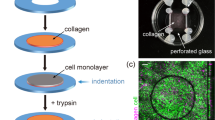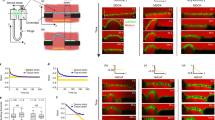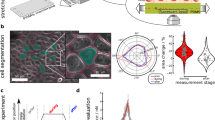Abstract
Many soft bodied coelenterates are highly deformable or contractile. In the absence of hard skeletal elements, the epithelia are subjected to mechanical forces which cause a wide range of structural changes in the component epithelial cells. What kinds of structural change occur and how are the cells adapted to them? These questions are addressed with reference to cell surface area, cell membranes, cell junctions and epithelial cilia.
Similar content being viewed by others
References
Batham, E. J., 1960. The fine structure of epithelium and mesogloea in a sea anemone. Q. Jl microsc. Sci. 101: 481–486.
Batham, E. J. & C. F. A. Pantin, 1951. The organisation of the muscular system of Metridium senile. Q. Jl microsc. Sci. 92: 27–54.
Green, C. R. & N. E. Flower, 1980. Two new septate junctions in the phylum Coelenterata. J. Cell Sci. 42: 43–59.
Hand, A. R. & G. Gobel, 1972. The structural organisation of the septate and gap junctions of Hydra. J. Cell Biol. 52: 397–408.
Hirokawa, N. & J. E. Heuser, 1981. Quick-freeze, deep-etch visualisation of the cytoskeleton beneath surface differentiations of intestinal epithelial cells. J. Cell Biol. 91: 399–409.
Holley, M. C., 1982. The control of anthozoan cilia by the basal apparatus. Tissue Cell 14: 607–620.
Holley, M. C., 1985a. Changes in the distribution of filamentcontaining septate junctions as coelenterate myoepithelial cells change shape. Tissue Cell 17: 1–11.
Holley, M. C., 1985b. Adaptation of a ciliary basal apparatus to cell shape changes in a contractile epithelium. Tissue Cell 17: 321–334.
Machemer, H., 1974. Ciliary activity and metachronism in Protozoa. In M. A. Sleigh (ed.), Cilia and Flagella. Academic Press, Lond.: 199–286.
Pitelka, D. R., 1974. Basal bodies and root structures. In M. A. Sleigh (ed.), Cilia and Flagella. Academic Press, Lond.: 437–469.
Rieger, R. M. & M. Mainitz, 1977. Comparative fine structure study of the body wall in Gnathostomulida and their phylogenetic position between Platyhelminthes and Aschelminthes. Z. zool. Syst. EvolForsch. 15: 9–35.
Robson, E. A., 1957. The structure and hydromechanics of the musculoepithelium in Metridium. Q. Jl microsc. Sci. 98: 265–278.
Sleigh, M. A., 1976. Fluid propulsion by cilia and the physiology of ciliary systems. In P. Spencer-Davies (ed.), Perspectives in Experimental Biology. Pergamon Press, Oxford: 125–134.
Sleigh, M. A. & N. R. Silvester, 1983. Anchorage functions of the basal apparatus of cilia. J. submicrosc. Cytol. 15: 101–104.
Author information
Authors and Affiliations
Rights and permissions
About this article
Cite this article
Holley, M.C. Problems of being a cell in a soft body. Hydrobiologia 216, 35–38 (1991). https://doi.org/10.1007/BF00026440
Issue Date:
DOI: https://doi.org/10.1007/BF00026440




